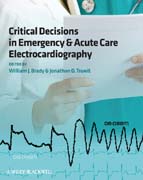
This scenario-based text provides answers to urgent and emergent questions inacute, emergency, and critical care situations focusing on the electrocardiogram in patient care management. The text is arranged in traditional topics areas such as ACS, dysrhythmia, etc yet each chapter is essentially a question with several cases illustrating the clinical dilemma the chapter itself is a specific answer to the question.This is a unique format among textbooks with an ECG focus. The clinical scenarios cover the issues involved in detecting and managing major cardiovascular conditions. Focused, structured discussion then solves these problems in a clinically relevant, rapid, and easy to read fashion.This novel approach to ECG instruction is ideal for practicing critical care and emergency physicians, specialist nurses, cardiologists, as well as studentsand trainees with a special interest in the ECG. INDICE: Contributors.Preface.Forewords.PART I The ECG in Clinical Practice.1 What are the clinical applications of the ECG in emergency and critical care?.2 What are the indications for the ECG in the pediatric emergency department?.3 What are the Limitations of the ECG in Clinical Practice?.4 Is the ECG indicated in stable, non-cardiac patients admitted to the hospital?.5 What is the use of the electrocardiogram in preoperative assessment and cardiovascular risk stratification?.6 Which patients benefit from continuous electrocardiographic monitoring during hospitalization?.PART II The ECG in Cardinal Presentations.7 How should the ECG be used in the syncope patient?.8 How should the ECG be used in the chest pain patient?.9 How should the ECG be used in the dyspneicpatient?.10 How should the ECG be used in the patient with altered mentation?.11 How should the ECG be used in the patient with cardiac arrest? .following cardiac arrest?.12 What is the impact / proper role of the ECG in the undifferentiated cardiorespiratory failure patient?.PART III The ECG in ACS.13 What isthe Role of the ECG in ACS?.14 What pseudoinfarction patterns mimic ST elevation myocardial infarction?.15 What ECG changes might myocardial ischemia causeother than ST-segment elevation or Q-waves and what are the differential diagnoses of these changes?.16 What is a Hyperacute T-Wave?.17 What is the significance of Q-waves?.18 What are the ECG Indications for Additional Electrocardiographic Leads (including electrocardiographic body-surface mapping) in Chest Pain Patients?Ch19 What further diagnostic adjuncts to the standard 12-lead ECGmay help to diagnose ACS?.20 Is Serial Electrocardiography (Serial ECGs and ST segment monitoring) of value in the ECG diagnosis of ACS?.21 What QRS Complex Abnormalities Result in ST Segment Elevation That May Mimic or Obscure AMI?.22 What are the Electrocardiographically Silent Areas of the Heart?.23 What isthe value of the pre-hospital acquired 12-lead electrocardiogram?.24 What arethe electrocardiographic indications for reperfusion therapy?.25 What are theECG Indications of Reperfusion and Reocclusion?.26 Does localization of the anatomic segment / identification of the infarct-related artery affect care in the ED?.27 Can the ECG be used to predict cardiovascular risk and acute complications in ACS?.PART IV The Dysrhythmic ECG.28 Can the electrocardiogram determine the rhythm diagnosis in narrow complex tachycardia?.29 Can the ECG Guide Treatment of Narrow QRS Tachycardia?.30 How can the ECG guide the diagnosis and management of wide complex tachycardias?.31 Can the ECG guide management in the patient with bradydysrhythmias?Ch32 What are the electrocardiographic indications for temporary cardiac pacing?Ch33 Can the ECG accurately diagnose pacemaker malfunction and/or complication?.34 How can the ECG guide acute therapy in the Wolff-Parkinson-White (WPW) patient?.35 What is the role of the ECG in PEA cardiac arrest scenarios?.PART V The ECG in Critical Care.36 What is the role of the ECG in the critically ill (non-coronary) patient?.37 Can the ECG distinguish between coronary and non-coronary etiologies in the critically ill patient?.38 What is the role of the ECG in therapeutic considerations / medicalmanagement decisions in the critically ill patient?.39 Can the ECG predict risk in the critically ill, non-coronary patient?.40 What is the proper role of the ECG in the evaluation of the patient with suspected PE?.41 What is the role / impact of the ECG in the patient with hyperkalemia?.42 What is the role / impact of the ECG in the patient with non-potassium electrolyte abnormalities?.43 What is value of the ECG in the hypothermic patient?.44 What are the non-ACS deadly ECG presentations?.PART VI The Toxicologic ECG.45 How useful is the ECG in the evaluation of the poisoned patient?.46 Can the Electrocardiogram guide management in the critically ill, poisoned patient?.47 Do characteristics of the QRS complex in the poisoned patient correlate with outcome?.48 What is the Treatment for Wide-Complex Dysrhythmias in the Poisoned Patient?.PART VII Electrocardiographic Differential Diagnosis.49 What is the ECG differential diagnosis of ST segment elevation?.50 What is the ECG differential diagnosis of ST segment depression?.51 What is the ECG differential diagnosis of the abnormal T wave?.52 What is the ECG differential diagnosis of narrow complex tachycardia?.53 What is the ECG differential diagnosis of wide complex tachycardia?.54 What is the ECG differential diagnosis of bradycardia?.55 What is the ECG differential diagnosis of the abnormal (wide and / or large) QRS complex?.56 What is the ECG differential diagnosis of a prolonged QT interval?
- ISBN: 978-1-4051-5906-7
- Editorial: Wiley-Blackwell
- Encuadernacion: Rústica
- Páginas: 488
- Fecha Publicación: 02/01/2009
- Nº Volúmenes: 1
- Idioma: Inglés
